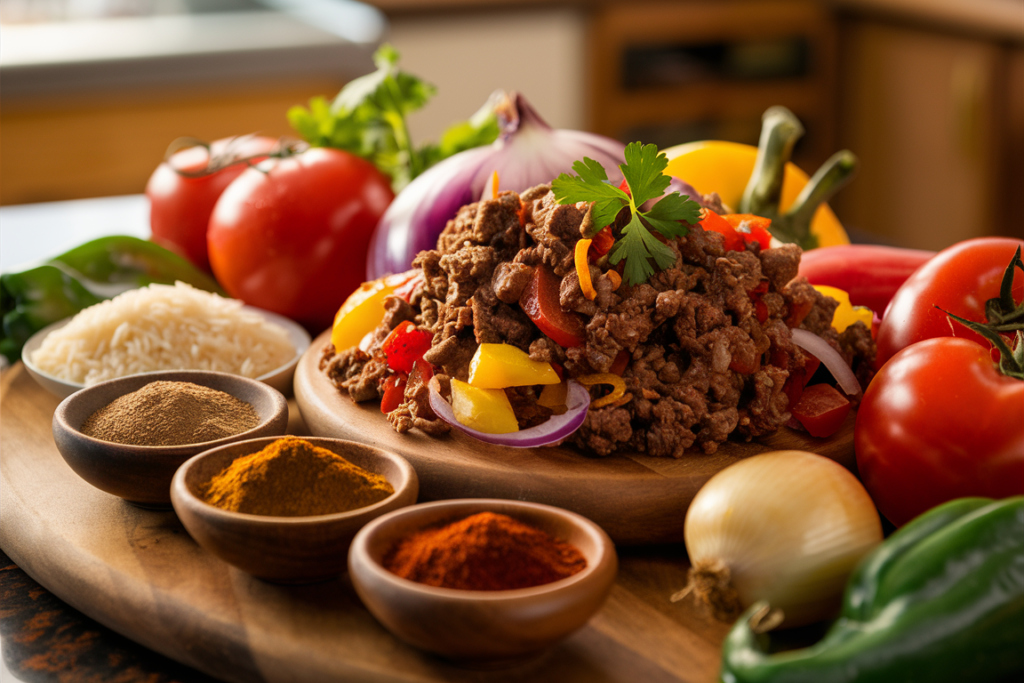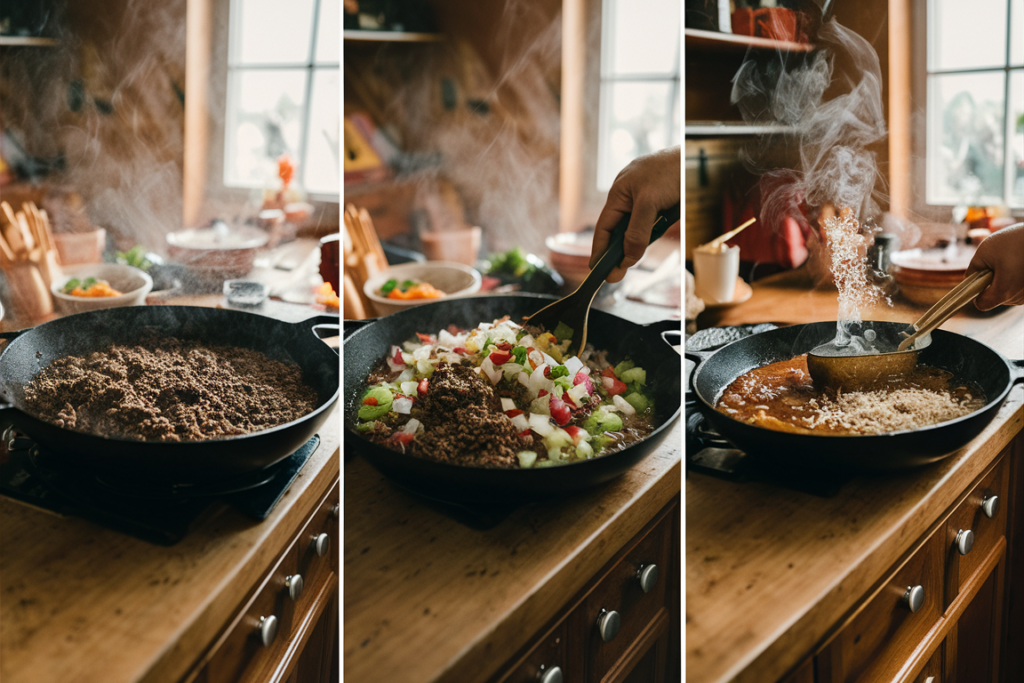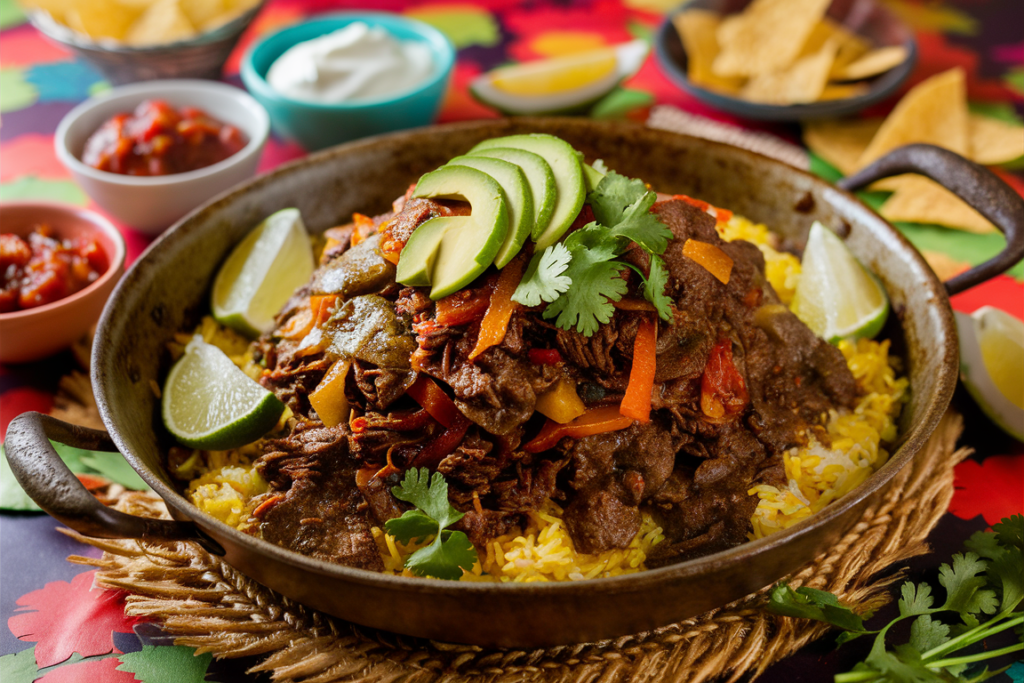Part 1: Introduction and Basics
1. Introduction
The Mexican Beef and Rice Skillet is a versatile, one-pan dish that has become a favorite for families and busy individuals alike. Packed with bold flavors, hearty ingredients, and an unbeatable aroma, this recipe captures the essence of Mexican cuisine in every bite.
But what makes it truly exceptional is its simplicity. Whether you’re a culinary novice or an experienced chef, this skillet meal is quick to prepare, offers minimal cleanup, and satisfies even the pickiest of eaters. The combination of savory beef, tender rice, and flavorful spices brings the warmth and vibrancy of Mexican flavors to your table.

2. Ingredients Overview
The beauty of this dish lies in its harmony of ingredients. Here’s a quick rundown of the essentials:
- Beef: The star protein, offering richness and flavor.
- Rice: The foundation that absorbs the spices and juices.
- Vegetables: Tomatoes, bell peppers, onions, and optional add-ins like corn and beans.
- Spices: Traditional Mexican spices like cumin, chili powder, and paprika elevate the dish.
- Cheese: For that melty, gooey finishing touch.
For the best results, opt for fresh and authentic ingredients. Fresh produce enhances flavor, while quality beef ensures tenderness.
3. Types of Beef
Choosing the right beef can make or break your dish. Here’s what you need to know:
- Ground Beef: The most commonly used option due to its quick cooking time and affordability. Opt for an 80/20 lean-to-fat ratio for balanced flavor.
- Shredded Beef: A more luxurious choice, ideal for those who prefer slow-cooked meals. It requires a longer preparation time but offers unmatched tenderness.
Pro Tip: For a lighter version, try ground turkey or chicken.
4. Rice Varieties
Not all rice is created equal when it comes to this dish. The texture and absorption rate play crucial roles in achieving the perfect skillet.
- White Rice: The traditional choice for its quick cooking time and ability to absorb flavors.
- Brown Rice: A healthier alternative with a nutty flavor. Requires longer cooking time but adds a hearty texture.
- Jasmine or Basmati Rice: If you’re seeking a fragrant twist, these options deliver a unique aroma.
Cook rice to perfection by rinsing it thoroughly and using the right water-to-rice ratio. For extra flavor, cook it in chicken or vegetable broth.
5. Seasoning Essentials
The seasoning is the heart of the Mexican Beef and Rice Skillet. A perfect balance of spices can transform the dish from good to spectacular.
- Must-Have Spices: Cumin, chili powder, paprika, garlic powder, and onion powder are the base.
- Optional Additions: Smoked paprika, oregano, or cayenne for a kick.
Balancing spice levels ensures the dish is enjoyable for everyone. If you’re cooking for kids or spice-sensitive individuals, start with milder quantities and adjust as needed.
6. Role of Vegetables
Vegetables are more than just a filler; they enhance texture, color, and nutritional value.
- Key Vegetables: Tomatoes add juiciness, bell peppers provide crunch and sweetness, and onions contribute a savory depth.
- Optional Additions: Corn kernels for a pop of sweetness, black beans for protein, or jalapeños for heat.
To keep veggies vibrant and crisp, add them in stages based on their cooking time.
7. Importance of Cheese
Cheese is the crowning glory of this skillet dish. It melts into the rice and beef, creating a creamy, indulgent layer.
- Best Options: Cheddar, Monterey Jack, or a Mexican blend for authenticity.
- Dairy-Free Alternatives: Plant-based cheeses that melt well, like almond or cashew-based options.
Tip: Sprinkle cheese just before serving for the ultimate ooey-gooey effect.
8. Nutrition Profile
This dish is a nutritional powerhouse when made with fresh, wholesome ingredients. Here’s a breakdown:
- Calories: Approximately 400-500 per serving (varies by portion size).
- Protein: High, thanks to the beef and optional beans.
- Carbohydrates: From the rice and vegetables, providing energy.
- Vitamins and Minerals: Loaded with vitamin C, iron, and potassium.
For a lighter option, swap white rice for quinoa or use leaner meat.
9. Kitchen Tools Needed
To make the perfect Mexican Beef and Rice Skillet, you’ll need a few essential tools:
- Skillet: A large, non-stick or cast-iron skillet ensures even cooking.
- Spatula: For stirring and flipping.
- Cutting Board and Knife: For prepping vegetables and meat.
Invest in a quality skillet—it’s the backbone of this dish.
10. Quick Recipe Overview
Here’s a summary of the process:
- Cook the beef: Brown it until fully cooked.
- Add spices and vegetables: Let them sauté until aromatic.
- Incorporate rice and liquid: Cook until the rice absorbs all the flavors.
- Top with cheese: Let it melt for a luscious finish.
This simple process saves time without compromising flavor, making it ideal for weeknight dinners or meal prep.
Part 2: Preparation and Cooking Process
11. Preparing the Ingredients
The first step to a successful Mexican Beef and Rice Skillet is proper ingredient preparation.

- Vegetables: Chop your onions, bell peppers, and tomatoes into uniform pieces for even cooking. This ensures that each bite has a balance of flavors.
- Rice: Decide whether to use pre-cooked or uncooked rice. Pre-cooked rice can save time, while uncooked rice absorbs the skillet’s flavors better.
- Spices: Measure and combine the spices in a small bowl beforehand. This helps streamline the cooking process.
Pro Tip: If you’re short on time, use pre-chopped vegetables or frozen options without sacrificing much flavor.
12. Sautéing the Beef
Browning the beef is crucial for developing rich, savory flavors.
- Steps:
- Heat the skillet over medium-high heat and add a small amount of oil.
- Add the beef, breaking it into small pieces with a spatula.
- Cook until browned and no longer pink.
- Tips:
- Avoid overcrowding the skillet to ensure even browning.
- If using ground beef, drain excess grease to keep the dish light.
- For shredded beef, sear it first for added flavor before slow-cooking.
13. Adding Vegetables
Vegetables should be added in the right order to maintain their texture.
- Best Order:
- Start with onions to build a flavor base.
- Add bell peppers and tomatoes next, cooking until slightly softened.
- Toss in quick-cooking options like corn or beans toward the end.
Avoid overcooking to retain a slight crunch and vibrant color.
14. Integrating Spices
The secret to a flavorful skillet is how you incorporate the spices.
- Steps:
- Sprinkle the spice blend evenly over the beef and vegetables.
- Stir well to coat all ingredients.
- Allow the spices to bloom in the heat for 1-2 minutes before adding liquids.
- Adjusting Flavor:
- Taste as you go and adjust seasoning gradually.
- Add a squeeze of lime juice for acidity or a pinch of sugar to balance heat.
15. Cooking the Rice
The rice absorbs the spices, beef juices, and vegetable flavors, making it the dish’s backbone.
- For Uncooked Rice:
- Add the rice directly to the skillet, stirring it to coat in the seasonings.
- Pour in broth or water (use a 2:1 liquid-to-rice ratio).
- Cover and simmer until the liquid is absorbed.
- For Pre-Cooked Rice:
- Stir the rice in toward the end of the cooking process to heat through without overcooking.
Tip: Use chicken or beef broth instead of water for extra depth.
16. Combining All Components
At this stage, the dish comes together beautifully.
- Layering vs Mixing:
- Layering the ingredients keeps textures distinct and visually appealing.
- Mixing ensures an even distribution of flavors.
Let the mixture simmer briefly to meld all the ingredients into a cohesive dish.
17. Garnishing the Dish
The finishing touches elevate the dish from great to unforgettable.
- Garnishes:
- Fresh cilantro for an herby aroma.
- Sliced avocados for creaminess.
- Lime wedges for a zesty kick.
- Creative Options:
- Sprinkle crushed tortilla chips for crunch.
- Add a dollop of sour cream or Greek yogurt for tanginess.
Garnishing allows you to customize the dish to your preferences or impress guests with a beautiful presentation.
18. Cooking Variations
This dish is incredibly versatile, allowing for endless modifications.
- Vegetarian:
- Replace beef with plant-based meat crumbles or diced tofu.
- Add more beans, mushrooms, or roasted vegetables for protein and texture.
- Low-Carb:
- Swap rice for cauliflower rice or quinoa.
- Adjust the cooking time accordingly.
Experimenting with variations can keep this recipe fresh and exciting every time you make it.
19. Timing the Dish Perfectly
Timing is everything when cooking a one-pan dish to avoid overcooked or undercooked elements.
- Key Timings:
- Browning beef: 5-7 minutes.
- Cooking vegetables: 5 minutes.
- Simmering rice: 15-20 minutes (for uncooked rice).
- Tips:
- Stir occasionally to prevent sticking.
- Check rice periodically for doneness and add more liquid if needed.
Proper timing ensures all ingredients are perfectly cooked, flavorful, and tender.
20. Troubleshooting Common Issues
Even seasoned cooks encounter hiccups. Here’s how to fix common problems:
- Soggy Rice: Remove the lid and cook on low heat to evaporate excess liquid.
- Overly Spicy Dish: Add a dollop of sour cream, shredded cheese, or diced avocado to mellow the heat.
- Under-Seasoned Skillet: Sprinkle additional salt, lime juice, or spices toward the end.
Being prepared to troubleshoot ensures you’ll always end up with a delicious result.
Part 3: Serving, Storing, and Customizations
21. Serving Suggestions
Pairing your Mexican Beef and Rice Skillet with complementary sides and beverages enhances the dining experience.

- Side Dishes:
- Warm tortillas or tortilla chips for scooping.
- A simple green salad with a tangy vinaigrette to balance the rich flavors.
- Mexican street corn (elote) or roasted veggies for added flair.
- Beverages:
- A classic margarita or sangria for adults.
- Fresh limeade or horchata as non-alcoholic options.
Serving the skillet family-style in the same pan offers a rustic, cozy feel perfect for gatherings.
22. Presentation Tips
The way you present your skillet dish can make it more appealing to the eyes and palate.
- Plating Ideas:
- Serve directly from the skillet for a casual, rustic vibe.
- Use individual bowls, topping each with cheese, cilantro, and avocado slices for a polished presentation.
- Colorful Touches:
- Bright garnishes like chopped red onions or diced tomatoes add pops of color.
- A sprinkle of queso fresco or crumbled cotija cheese provides a textural contrast.
Small details like neatly arranged garnishes make the dish look as good as it tastes.
23. Storing Leftovers
Leftovers are a blessing with this dish, as the flavors deepen over time.
- Refrigeration:
- Let the dish cool completely before transferring it to an airtight container.
- Store in the refrigerator for up to 3-4 days.
- Reheating Tips:
- Heat on the stovetop with a splash of broth to restore moisture.
- Microwave in 1-minute intervals, stirring in between to heat evenly.
Proper storage and reheating techniques ensure that your dish tastes just as delicious the next day.
24. Freezing the Dish
If you’re planning ahead, the Mexican Beef and Rice Skillet is freezer-friendly.
- How to Freeze:
- Allow the dish to cool completely.
- Portion it into freezer-safe containers or bags, removing as much air as possible.
- Label with the date for easy tracking.
- Defrosting:
- Thaw overnight in the refrigerator for the best texture.
- Reheat gently on the stove or in the microwave.
Freezing makes this dish a convenient option for meal prep or unexpected guests.
25. Making it Spicy
If you love bold, fiery flavors, here are some ways to turn up the heat:
- Spicy Additions:
- Add fresh or dried chili peppers like jalapeños, serranos, or chipotle.
- Sprinkle in cayenne pepper or crushed red pepper flakes.
- Use a spicy salsa or hot sauce as a topping.
- Layering Heat:
- Add spice at multiple stages: in the beef, during seasoning, and as a garnish.
Remember to taste as you go to avoid overpowering the other flavors.
26. Making it Mild
For those who prefer a milder dish, adjust the spice level without compromising flavor.
- Substitutions:
- Replace chili powder with paprika for a milder smoky flavor.
- Skip spicy peppers and opt for sweet bell peppers instead.
- Kid-Friendly Adjustments:
- Reduce the amount of cumin and omit cayenne.
- Serve with a dollop of sour cream or yogurt to cool down the dish.
This ensures the dish remains approachable for all palates, especially children.
27. Fusion Ideas
Combining Mexican Beef and Rice Skillet with elements from other cuisines can lead to exciting new variations.
- Asian Fusion:
- Add soy sauce, ginger, and scallions for a teriyaki twist.
- Replace rice with fried rice or noodles.
- Mediterranean Fusion:
- Add olives, feta cheese, and a drizzle of tzatziki.
- Use couscous instead of rice.
- Caribbean Inspiration:
- Toss in diced pineapple and jerk seasoning for a sweet and spicy profile.
These fusion ideas make the dish versatile and adaptable to different tastes.
28. Budget-Friendly Tips
This dish can be made affordably without compromising quality.
- Cost-Effective Ingredients:
- Buy ground beef in bulk and freeze portions for later.
- Use frozen vegetables instead of fresh to reduce costs.
- Feeding a Crowd:
- Double the rice and vegetables while keeping the beef amount the same for a more budget-friendly option.
- Serve with inexpensive sides like refried beans or homemade salsa.
A little planning ensures the dish is both delicious and wallet-friendly.
29. Healthier Modifications
Transform the Mexican Beef and Rice Skillet into a healthier meal with a few simple tweaks.
- Lower-Calorie Options:
- Use lean ground turkey or chicken instead of beef.
- Replace white rice with cauliflower rice or quinoa for a lower-carb alternative.
- Reducing Fat and Sodium:
- Drain excess grease from the beef.
- Opt for low-sodium broth and spices.
These changes make the dish suitable for various dietary preferences without sacrificing flavor.
30. Frequently Asked Questions
- Can I use leftover rice?
Yes, you can! Add it during the final steps of cooking to avoid it becoming mushy. - What’s the best skillet to use?
A large cast-iron or non-stick skillet works best for even cooking and easy cleaning. - How can I prevent soggy rice?
Use the correct water-to-rice ratio and let the rice steam without stirring. - Can this dish be made vegetarian?
Yes! Swap the beef for black beans, pinto beans, or a plant-based protein. - Is this recipe gluten-free?
It is, as long as the spices and broth you use are certified gluten-free. - How can I add more vegetables?
Add zucchini, spinach, or diced carrots to boost nutrition. - What cheese works for dairy-free diets?
Use plant-based cheese that melts well, like almond or cashew-based options. - Can I make this in advance?
Yes, you can make it up to 2 days ahead and reheat it when ready to serve. - What’s the best way to store leftovers?
Keep leftovers in an airtight container in the fridge for up to 3-4 days or freeze them for up to 3 months. - How do I balance overly spicy flavors?
Add sour cream, cheese, or a squeeze of lime to reduce the heat.

